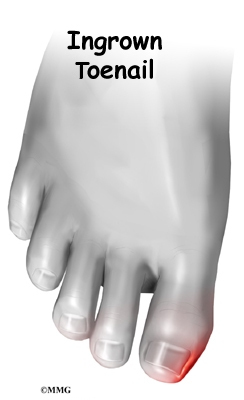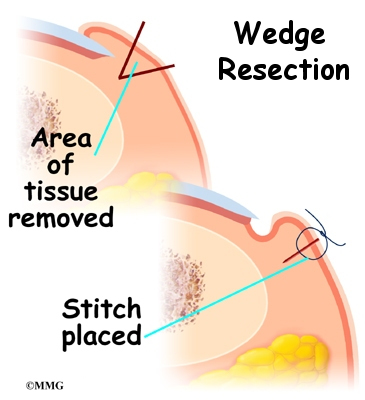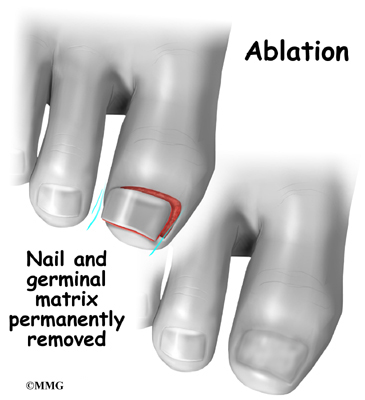A Patient's Guide to Ingrown Toenail
Introduction
Ingrown toenail is a condition that most commonly affects the hallux, or big toe. This condition usually results when pressure from improper shoe wear and improper care of the toenails leads to pain and overgrowth of the tissue at the side of the nail.
This guide will help you understand
- how an ingrown toenail develops
- why it causes problems
- what can be done to treat the condition
Anatomy
How does a toenail normally grow?
The toenail (and any other nail) is produced by the nail's germinal matrix (special nail-generating tissue) and grows forward to the end of the toe. Most of us have lost either a fingernail or toenail and watched as the nail regrew slowly over several months. The area under the nail that attaches the nail to the toe is called the sterile matrix. The sterile matrix doesn't produce the nail. The sterile matrix just attaches the nail to the toe. On either side of the nail is an area called the nail groove, where the skin of the toe meets the nail matrix and the edge of the toenail.
Related Document: A Patient's Guide to Foot Anatomy
Causes
How does the problem develop?
In the case of the ingrown toenail, the nail groove begins to disappear, probably due to pressure from ill fitting shoes. The chronic pressure of the nail edge rubbing against the nail groove causes irritation and swelling of the surrounding skin. If the condition continues, hypertrophy, or overgrowth, of the tissue, leads to permanent changes in the tissue. These changes only make the situation worse. Eventually, an infection can occur in the area, leading to even more pain and swelling. Improper trimming of the toenail can also cause problems. If the corner of the toenail is not allowed to grow out past the skin at the end of the nail groove, it may dig into the skin. This makes the pressure from the shoe even more painful.
Symptoms
What does an ingrown toenail feel like?
The primary symptom of an ingrown toenail is pain. The toe is red and painful to the touch, and it can be difficult to wear shoes. If infection is present, pus may drain from the area as well.
Diagnosis
How will my doctor confirm it's an ingrown toenail?
Diagnosis is generally easily made on examination. No X-rays or tests are usually required, unless your doctor suspects that the infection may have spread to the bone.
Treatment
What can be done for the condition?
Nonsurgical Treatment
If caught early, nonsurgical treatment may suffice. Pressure on the toe should be reduced to a minimum with sandals or simply not wearing a shoe for several days. The temptation to trim the corner of the toenail off should be avoided. This can lead to a worse condition where the toenail forms a fish hook deformity that further grows into the nail groove. The goal of nonsurgical treatment is to allow the toenail to grow out to the end of the toe beyond the nail groove. Intermittent soaks in a warm saline solution may be suggested. If the area is infected, antibiotics may be necessary to eliminate the infection.
Once the condition has resolved, shoes should be found that do not put too much pressure on the big toe. The nails should be trimmed straight across and never below the end of the nail groove.
Surgery
If the condition has resulted in permanent hypertrophy of the tissue surrounding the nail margin, surgery may be required to treat the condition.
Wedge Resection
In mild cases, removal of a portion of the hypertrophied tissue may reduce the pressure and irritation. In this procedure, a wedge of tissue is removed and the healing process allows the nail groove to reform itself.
Partial Nail and Matrix Removal
More severe cases may require removal of a portion of the toenail and the germinal matrix that produces that portion of the nail.
Nail and Matrix Ablation
Finally, in cases of severe deformity, the entire nail and its germinal matrix may need to be removed. This is called a nail ablation. No new toenail will grow back. This should be done only as last resort.
These procedures can usually be done in your doctor's office under local anesthetic.
Rehabilitation
What should I expect after treatment?
Nonsurgical Rehabilitation
If your doctor recommends nonsurgical treatment, you should begin to see some improvement in your symptoms within a few days.
Soaking the sore foot and making simple changes to your footwear may allow you to resume normal walking nearly immediately. But you should probably cut back on more vigorous activities for several weeks to allow the inflammation and pain to subside.
After Surgery
It will take several weeks before the tissues are healed. You will probably wear a bandage or dressing for about a week following the procedure. Your surgeon may recommend soaking the toe in warm salt water each day for the first week after surgery.
|











